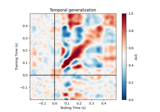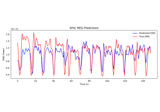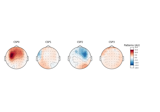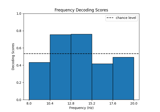mne.decoding.CSP¶
- class mne.decoding.CSP(n_components=4, reg=None, log=None, cov_est='concat', transform_into='average_power', norm_trace=False, cov_method_params=None, rank=None, component_order='mutual_info')[source]¶
M/EEG signal decomposition using the Common Spatial Patterns (CSP).
This class can be used as a supervised decomposition to estimate spatial filters for feature extraction. CSP in the context of EEG was first described in 1; a comprehensive tutorial on CSP can be found in 2. Multi-class solving is implemented from 3.
- Parameters
- n_components
int(default 4) The number of components to decompose M/EEG signals. This number should be set by cross-validation.
- reg
float|str|None(defaultNone) If not None (same as
'empirical', default), allow regularization for covariance estimation. If float (between 0 and 1), shrinkage is used. For str values,regwill be passed asmethodtomne.compute_covariance().- log
None| bool (defaultNone) If
transform_intoequals'average_power'andlogis None or True, then apply a log transform to standardize features, else features are z-scored. Iftransform_intois'csp_space',logmust be None.- cov_est‘concat’ | ‘epoch’ (default ‘concat’)
If
'concat', covariance matrices are estimated on concatenated epochs for each class. If'epoch', covariance matrices are estimated on each epoch separately and then averaged over each class.- transform_into‘average_power’ | ‘csp_space’ (default ‘average_power’)
If ‘average_power’ then
self.transformwill return the average power of each spatial filter. If'csp_space',self.transformwill return the data in CSP space.- norm_tracebool (default
False) Normalize class covariance by its trace. Trace normalization is a step of the original CSP algorithm 1 to eliminate magnitude variations in the EEG between individuals. It is not applied in more recent work 2, 3 and can have a negative impact on pattern order.
- cov_method_params
dict|None Parameters to pass to
mne.compute_covariance().New in version 0.16.
- rank
None| ‘info’ | ‘full’ |dict This controls the rank computation that can be read from the measurement info or estimated from the data. When a noise covariance is used for whitening, this should reflect the rank of that covariance, otherwise amplification of noise components can occur in whitening (e.g., often during source localization).
NoneThe rank will be estimated from the data after proper scaling of different channel types.
'info'The rank is inferred from
info. If data have been processed with Maxwell filtering, the Maxwell filtering header is used. Otherwise, the channel counts themselves are used. In both cases, the number of projectors is subtracted from the (effective) number of channels in the data. For example, if Maxwell filtering reduces the rank to 68, with two projectors the returned value will be 66.'full'The rank is assumed to be full, i.e. equal to the number of good channels. If a
Covarianceis passed, this can make sense if it has been (possibly improperly) regularized without taking into account the true data rank.dictCalculate the rank only for a subset of channel types, and explicitly specify the rank for the remaining channel types. This can be extremely useful if you already know the rank of (part of) your data, for instance in case you have calculated it earlier.
This parameter must be a dictionary whose keys correspond to channel types in the data (e.g.
'meg','mag','grad','eeg'), and whose values are integers representing the respective ranks. For example,{'mag': 90, 'eeg': 45}will assume a rank of90and45for magnetometer data and EEG data, respectively.The ranks for all channel types present in the data, but not specified in the dictionary will be estimated empirically. That is, if you passed a dataset containing magnetometer, gradiometer, and EEG data together with the dictionary from the previous example, only the gradiometer rank would be determined, while the specified magnetometer and EEG ranks would be taken for granted.
The default is
None.New in version 0.17.
- component_order‘mutual_info’ | ‘alternate’ (default ‘mutual_info’)
If
'mutual_info'order components by decreasing mutual information (in the two-class case this uses a simplification which orders components by decreasing absolute deviation of the eigenvalues from 0.5 4). For the two-class case,'alternate'orders components by starting with the largest eigenvalue, followed by the smallest, the second-to-largest, the second-to-smallest, and so on 2.New in version 0.21.
- n_components
See also
References
- 1(1,2)
Zoltan J. Koles, Michael S. Lazar, and Steven Z. Zhou. Spatial patterns underlying population differences in the background EEG. Brain Topography, 2(4):275–284, 1990. doi:10.1007/BF01129656.
- 2(1,2,3)
Benjamin Blankertz, Ryota Tomioka, Steven Lemm, Motoaki Kawanabe, and Klaus-Robert Müller. Optimizing spatial filters for robust EEG single-trial analysis. IEEE Signal Processing Magazine, 25(1):41–56, 2008. doi:10.1109/MSP.2008.4408441.
- 3(1,2)
Moritz Grosse-Wentrup and Martin Buss. Multiclass common spatial patterns and information theoretic feature extraction. IEEE Transactions on Biomedical Engineering, 55(8):1991–2000, 2008. doi:10.1109/TBME.2008.921154.
- 4
Alexandre Barachant, Stephane Bonnet, Marco Congedo, and Christian Jutten. Common spatial pattern revisited by Riemannian geometry. In 2010 IEEE International Workshop on Multimedia Signal Processing, 472–476. 2010. doi:10.1109/MMSP.2010.5662067.
- Attributes
- filters_
ndarray, shape (n_channels, n_channels) If fit, the CSP components used to decompose the data, else None.
- patterns_
ndarray, shape (n_channels, n_channels) If fit, the CSP patterns used to restore M/EEG signals, else None.
- mean_
ndarray, shape (n_components,) If fit, the mean squared power for each component.
- std_
ndarray, shape (n_components,) If fit, the std squared power for each component.
- filters_
Methods
__hash__(/)Return hash(self).
fit(X, y)Estimate the CSP decomposition on epochs.
fit_transform(X[, y])Fit to data, then transform it.
get_params([deep])Get parameters for this estimator.
plot_filters(info[, components, ch_type, ...])Plot topographic filters of components.
plot_patterns(info[, components, ch_type, ...])Plot topographic patterns of components.
set_params(**params)Set the parameters of this estimator.
transform(X)Estimate epochs sources given the CSP filters.
- fit(X, y)[source]¶
Estimate the CSP decomposition on epochs.
- Parameters
- Returns
- selfinstance of
CSP Returns the modified instance.
- selfinstance of
Examples using
fit:
- fit_transform(X, y=None, **fit_params)[source]¶
Fit to data, then transform it.
Fits transformer to X and y with optional parameters fit_params and returns a transformed version of X.
- Parameters
- Returns
- X_new
array, shape (n_samples, n_features_new) Transformed array.
- X_new
Examples using
fit_transform:
- plot_filters(info, components=None, ch_type=None, vmin=None, vmax=None, cmap='RdBu_r', sensors=True, colorbar=True, scalings=None, units='a.u.', res=64, size=1, cbar_fmt='%3.1f', name_format='CSP%01d', show=True, show_names=False, title=None, mask=None, mask_params=None, outlines='head', contours=6, image_interp='bilinear', average=None)[source]¶
Plot topographic filters of components.
The filters are used to extract discriminant neural sources from the measured data (a.k.a. the backward model).
- Parameters
- info
mne.Info The
mne.Infoobject with information about the sensors and methods of measurement. Used for fitting. If not available, consider usingmne.create_info().- components
float|arrayoffloat|None The patterns to plot. If None, n_components will be shown.
- ch_type‘mag’ | ‘grad’ | ‘planar1’ | ‘planar2’ | ‘eeg’ |
None The channel type to plot. For ‘grad’, the gradiometers are collected in pairs and the RMS for each pair is plotted. If None, then first available channel type from order given above is used. Defaults to None.
- vmin
float|callable() The value specifying the lower bound of the color range. If None, and vmax is None, -vmax is used. Else np.min(data). If callable, the output equals vmin(data).
- vmax
float|callable() The value specifying the upper bound of the color range. If None, the maximum absolute value is used. If vmin is None, but vmax is not, defaults to np.min(data). If callable, the output equals vmax(data).
- cmapmatplotlib colormap | (colormap, bool) | ‘interactive’ |
None Colormap to use. If tuple, the first value indicates the colormap to use and the second value is a boolean defining interactivity. In interactive mode the colors are adjustable by clicking and dragging the colorbar with left and right mouse button. Left mouse button moves the scale up and down and right mouse button adjusts the range. Hitting space bar resets the range. Up and down arrows can be used to change the colormap. If None, ‘Reds’ is used for all positive data, otherwise defaults to ‘RdBu_r’. If ‘interactive’, translates to (None, True). Defaults to ‘RdBu_r’.
Warning
Interactive mode works smoothly only for a small amount of topomaps.
- sensorsbool |
str Add markers for sensor locations to the plot. Accepts matplotlib plot format string (e.g., ‘r+’ for red plusses). If True, a circle will be used (via .add_artist). Defaults to True.
- colorbarbool
Plot a colorbar.
- scalings
dict|float|None The scalings of the channel types to be applied for plotting. If None, defaults to
dict(eeg=1e6, grad=1e13, mag=1e15).- units
dict|str|None The unit of the channel type used for colorbar label. If scale is None the unit is automatically determined.
- res
int The resolution of the topomap image (n pixels along each side).
- size
float Side length per topomap in inches.
- cbar_fmt
str String format for colorbar values.
- name_format
str String format for topomap values. Defaults to “CSP%01d”.
- showbool
Show figure if True.
- show_namesbool |
callable() If True, show channel names on top of the map. If a callable is passed, channel names will be formatted using the callable; e.g., to delete the prefix ‘MEG ‘ from all channel names, pass the function lambda x: x.replace(‘MEG ‘, ‘’). If
maskis not None, only significant sensors will be shown.- title
str|None Title. If None (default), no title is displayed.
- mask
ndarrayof bool, shape (n_channels, n_times) |None The channels to be marked as significant at a given time point. Indices set to
Truewill be considered. Defaults to None.- mask_params
dict|None Additional plotting parameters for plotting significant sensors. Default (None) equals:
dict(marker='o', markerfacecolor='w', markeredgecolor='k', linewidth=0, markersize=4)
- outlines‘head’ | ‘skirt’ |
dict|None The outlines to be drawn. If ‘head’, the default head scheme will be drawn. If ‘skirt’ the head scheme will be drawn, but sensors are allowed to be plotted outside of the head circle. If dict, each key refers to a tuple of x and y positions, the values in ‘mask_pos’ will serve as image mask. Alternatively, a matplotlib patch object can be passed for advanced masking options, either directly or as a function that returns patches (required for multi-axis plots). If None, nothing will be drawn. Defaults to ‘head’.
- contours
int|arrayoffloat The number of contour lines to draw. If 0, no contours will be drawn. When an integer, matplotlib ticker locator is used to find suitable values for the contour thresholds (may sometimes be inaccurate, use array for accuracy). If an array, the values represent the levels for the contours. Defaults to 6.
- image_interp
str The image interpolation to be used. All matplotlib options are accepted.
- average
float|None The time window around a given time to be used for averaging (seconds). For example, 0.01 would translate into window that starts 5 ms before and ends 5 ms after a given time point. Defaults to None, which means no averaging.
- info
- Returns
- figinstance of
matplotlib.figure.Figure The figure.
- figinstance of
Examples using
plot_filters:
- plot_patterns(info, components=None, ch_type=None, vmin=None, vmax=None, cmap='RdBu_r', sensors=True, colorbar=True, scalings=None, units='a.u.', res=64, size=1, cbar_fmt='%3.1f', name_format='CSP%01d', show=True, show_names=False, title=None, mask=None, mask_params=None, outlines='head', contours=6, image_interp='bilinear', average=None, sphere=None)[source]¶
Plot topographic patterns of components.
The patterns explain how the measured data was generated from the neural sources (a.k.a. the forward model).
- Parameters
- info
mne.Info The
mne.Infoobject with information about the sensors and methods of measurement. Used for fitting. If not available, consider usingmne.create_info().- components
float|arrayoffloat|None The patterns to plot. If None, n_components will be shown.
- ch_type‘mag’ | ‘grad’ | ‘planar1’ | ‘planar2’ | ‘eeg’ |
None The channel type to plot. For ‘grad’, the gradiometers are collected in pairs and the RMS for each pair is plotted. If None, then first available channel type from order given above is used. Defaults to None.
- vmin
float|callable() The value specifying the lower bound of the color range. If None, and vmax is None, -vmax is used. Else np.min(data). If callable, the output equals vmin(data).
- vmax
float|callable() The value specifying the upper bound of the color range. If None, the maximum absolute value is used. If vmin is None, but vmax is not, default np.min(data). If callable, the output equals vmax(data).
- cmapmatplotlib colormap | (colormap, bool) | ‘interactive’ |
None Colormap to use. If tuple, the first value indicates the colormap to use and the second value is a boolean defining interactivity. In interactive mode the colors are adjustable by clicking and dragging the colorbar with left and right mouse button. Left mouse button moves the scale up and down and right mouse button adjusts the range. Hitting space bar resets the range. Up and down arrows can be used to change the colormap. If None, ‘Reds’ is used for all positive data, otherwise defaults to ‘RdBu_r’. If ‘interactive’, translates to (None, True). Defaults to ‘RdBu_r’.
Warning
Interactive mode works smoothly only for a small amount of topomaps.
- sensorsbool |
str Add markers for sensor locations to the plot. Accepts matplotlib plot format string (e.g., ‘r+’ for red plusses). If True, a circle will be used (via .add_artist). Defaults to True.
- colorbarbool
Plot a colorbar.
- scalings
dict|float|None The scalings of the channel types to be applied for plotting. If None, defaults to
dict(eeg=1e6, grad=1e13, mag=1e15).- units
dict|str|None The unit of the channel type used for colorbar label. If scale is None the unit is automatically determined.
- res
int The resolution of the topomap image (n pixels along each side).
- size
float Side length per topomap in inches.
- cbar_fmt
str String format for colorbar values.
- name_format
str String format for topomap values. Defaults to “CSP%01d”.
- showbool
Show figure if True.
- show_namesbool |
callable() If True, show channel names on top of the map. If a callable is passed, channel names will be formatted using the callable; e.g., to delete the prefix ‘MEG ‘ from all channel names, pass the function lambda x: x.replace(‘MEG ‘, ‘’). If
maskis not None, only significant sensors will be shown.- title
str|None Title. If None (default), no title is displayed.
- mask
ndarrayof bool, shape (n_channels, n_patterns) |None Array indicating channel-pattern combinations to highlight with a distinct plotting style. Array elements set to
Truewill be plotted with the parameters given inmask_params. Defaults toNone, equivalent to an array of allFalseelements.- mask_params
dict|None Additional plotting parameters for plotting significant sensors. Default (None) equals:
dict(marker='o', markerfacecolor='w', markeredgecolor='k', linewidth=0, markersize=4)
- outlines‘head’ | ‘skirt’ |
dict|None The outlines to be drawn. If ‘head’, the default head scheme will be drawn. If ‘skirt’ the head scheme will be drawn, but sensors are allowed to be plotted outside of the head circle. If dict, each key refers to a tuple of x and y positions, the values in ‘mask_pos’ will serve as image mask. Alternatively, a matplotlib patch object can be passed for advanced masking options, either directly or as a function that returns patches (required for multi-axis plots). If None, nothing will be drawn. Defaults to ‘head’.
- contours
int|arrayoffloat The number of contour lines to draw. If 0, no contours will be drawn. When an integer, matplotlib ticker locator is used to find suitable values for the contour thresholds (may sometimes be inaccurate, use array for accuracy). If an array, the values represent the levels for the contours. Defaults to 6.
- image_interp
str The image interpolation to be used. All matplotlib options are accepted.
- average
float|None The time window around a given time to be used for averaging (seconds). For example, 0.01 would translate into window that starts 5 ms before and ends 5 ms after a given time point. Defaults to None, which means no averaging.
- sphere
float| array_like |str|None The sphere parameters to use for the cartoon head. Can be array-like of shape (4,) to give the X/Y/Z origin and radius in meters, or a single float to give the radius (origin assumed 0, 0, 0). Can also be a spherical ConductorModel, which will use the origin and radius. Can be “auto” to use a digitization-based fit. Can also be None (default) to use ‘auto’ when enough extra digitization points are available, and 0.095 otherwise. Currently the head radius does not affect plotting.
New in version 0.20.
- info
- Returns
- figinstance of
matplotlib.figure.Figure The figure.
- figinstance of
Examples using
plot_patterns:
- set_params(**params)[source]¶
Set the parameters of this estimator.
The method works on simple estimators as well as on nested objects (such as pipelines). The latter have parameters of the form
<component>__<parameter>so that it’s possible to update each component of a nested object.- Parameters
- **params
dict Parameters.
- **params
- Returns
- instinstance
The object.
- transform(X)[source]¶
Estimate epochs sources given the CSP filters.
- Parameters
- X
array, shape (n_epochs, n_channels, n_times) The data.
- X
- Returns
- X
ndarray If self.transform_into == ‘average_power’ then returns the power of CSP features averaged over time and shape (n_epochs, n_sources) If self.transform_into == ‘csp_space’ then returns the data in CSP space and shape is (n_epochs, n_sources, n_times).
- X
Examples using
transform:



